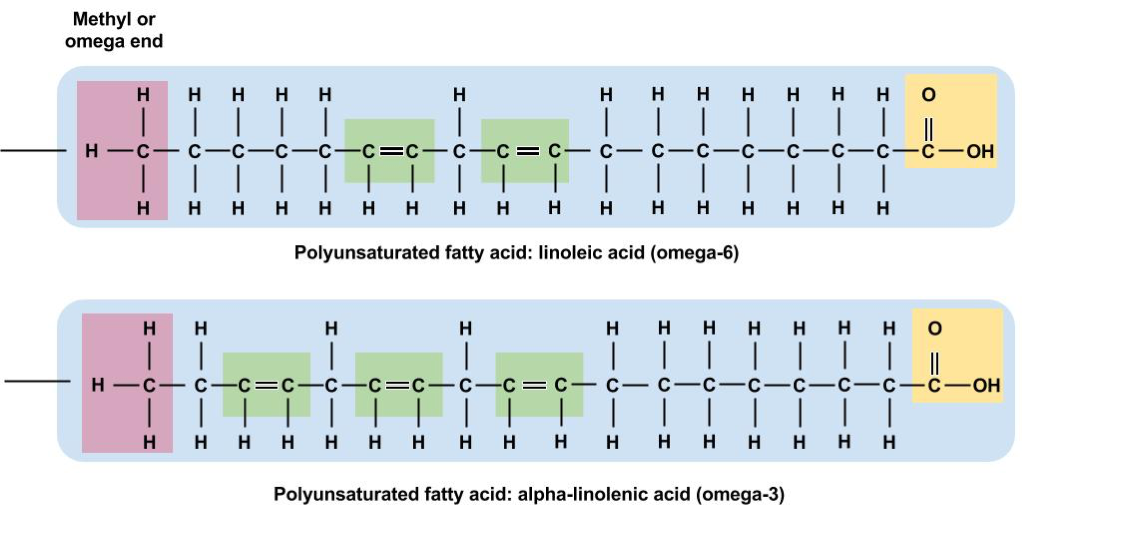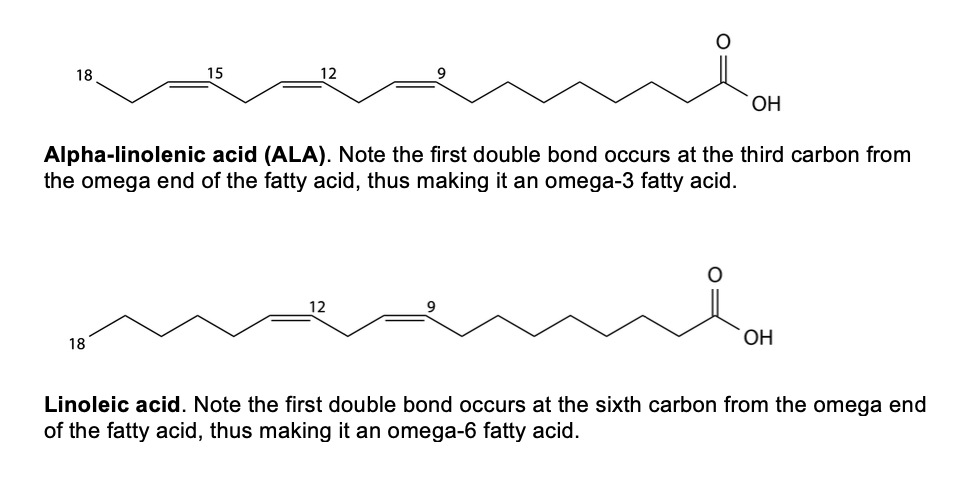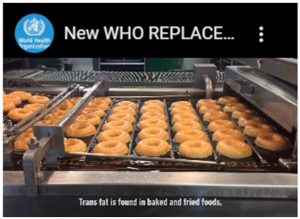Unit 5 – Lipids: Fats, Oils, and Cholesterol
5.2 Types and Sources of Fatty Acids
As mentioned in Unit 1, we should limit the amount of saturated (or solid) fats we eat while replacing them with unsaturated oils. What makes some fats saturated and others unsaturated? This page explains the different types of fats and how fatty acids can differ from one another in both carbon chain length and degree of saturation. These characteristics influence the resulting fat in many ways.
Chain Length of Fatty Acids
Fatty acids have different chain lengths, typically between four and 24 carbons, and most contain an even number. When the carbon chain length is shorter, the melting point of the fatty acid becomes lower (such as fats found in dairy products) and the fatty acid becomes more liquid. Longer chain lengths tend to result in more solid fats, although melting point is also influenced by the degree of saturation.
Degrees of Saturation of Fatty Acids
Fatty acid chains are composed primarily of carbon and hydrogen atoms that are bonded to each other. The term “saturation” refers to whether the carbon atom in a fatty acid chain is filled (or “saturated”) to capacity with hydrogen atoms. In a saturated fatty acid, each carbon is bonded to two hydrogen atoms, with single bonds between the carbons.
NOTE: Carbons must be bonded to four other atoms to be stable. The carbons in the saturated fatty acid in Figure 5.1 have four bonds with the carbon in the acid group “double bonded” to oxygen (C=O).
Alternatively, fatty acids can have points where hydrogen atoms are missing, because there is a double bond between carbons (C=C). This is referred to as a point of unsaturation, because the carbon is only bonded to one hydrogen atom instead of two. Unsaturated fatty acids have one or more points of unsaturation, or double bonds between the carbons. A monounsaturated fatty acid has one double bond, and a polyunsaturated fatty acid has two or more double bonds. Figure 5.1 shows the structures of the various types.
s.

Triglycerides in food contain a mixture of saturated, monounsaturated, and polyunsaturated fatty acids, but some foods are better sources of these types of fatty acids than others (Figure 5.2). For example, coconut oil is very high in saturated fat, but it still contains some monounsaturated and polyunsaturated fatty acids. Peanut oil is often thought of as a good source of monounsaturated fat, because that is the predominant fatty acid in the oil, but peanut oil also contains a fair amount of polyunsaturated fatty acids and even some saturated fatty acids.

Saturated Fatty Acids
Fat sources with a high percentage of saturated fatty acids tend to be solid at room temperature. The lack of double bonds in the carbon chains of saturated fatty acids makes them very straight, so they pack together well (like a box of toothpicks). Fats that have mostly saturated fatty acids, like butter and coconut oil, are solid at room temperature, as are the visible fat layers in a strip of bacon or a cut of beef. Consuming a diet high in saturated fats is associated with an increased risk of heart disease, because such a diet increases blood cholesterol, specifically the LDL (“bad”) cholesterol level. (More on this later.) Food sources of predominately saturated fatty acids include most animal fats (with the exception of poultry and eggs, which contain more unsaturated fatty acids), dairy products, tropical oils (like coconut and palm oil), cocoa butter, and partially or fully hydrogenated oils.

Unsaturated Fatty Acids
Fat sources rich in unsaturated fatty acids tend to be liquid at room temperature, because the C=C double bonds create bends in the carbon chain, making it harder for fatty acids to pack together tightly. Consuming a diet rich in mono- and polyunsaturated fats is associated with a lower LDL cholesterol level and a lower risk of heart disease.
Food sources of predominately monounsaturated fats include nuts and seeds like almonds, pecans, cashews, and peanuts; plant oils like canola, olive, and peanut oils; and avocados. The fat in poultry and eggs is predominantly unsaturated and contains more monounsaturated than polyunsaturated fatty acids.

Food sources of predominately polyunsaturated fats include plant oils (soybean, corn); fish; flaxseed; and some nuts like walnuts and pecans as shown in the figure below.

Omega-3, Omega-6, and Essential Fatty Acids
In addition to the length of the carbon chain and the number of double bonds, unsaturated fatty acids are also classified by the position of the first double bond relative to the methyl (-CH3) or “omega” end of the carbon chain (the end furthest from the glycerol backbone in a triglyceride). Fatty acids with the first double bond at the third carbon from the omega end are called omega-3 fatty acids. Those with the first double bond at the sixth carbon from the omega end are called omega-6 fatty acids. (There are also omega-9 fatty acids.)

The body is capable of making most of the fatty acids it needs. However, two fatty acids that the body cannot make are linoleic acid (an omega-6) and alpha-linolenic acid (ALA, an omega-3). These are called essential fatty acids because they must be consumed in the diet. Excellent food sources of linoleic fatty acid include plant oils such as corn oil and soybean oil, often found in salad dressings and margarine. Rich food sources of alpha-linolenic acid (ALA) include nuts, flaxseed, whole grains, legumes, and dark green leafy vegetables..

Most Americans easily consume enough linoleic acid and other omega-6 fatty acids, because corn and soybean oil are common ingredients in our food supply. However, sources of ALA and other omega-3 fatty acids are less common, and many people could benefit from incorporating more sources of these into their diet. As an added benefit, whole foods rich in ALA come packaged with other healthful nutrients, like fiber, protein, vitamins, minerals, and phytochemicals.
Omega-3 and omega-6 fatty acids are precursors to a large family of important signaling molecules called eicosanoids (prostaglandins are one type of eicosanoid). The term “eicosa”refers the 20 carbons they contain. Eicosanoids derived from omega-6 fatty acids tend to increase blood pressure, blood clotting, immune response, and inflammation. These are necessary functions, but they can be associated with disease when chronically elevated. In contrast, eicosanoids derived from omega-3 fatty acids tend to lower blood pressure, inflammation, and blood clotting, functions that can benefit heart health. Omega-3 and omega-6 fatty acids compete for the same enzymatic pathways in the formation of different eicosanoids, so increasing omega-3 fatty acids in the diet may have anti-inflammatory effects.
Two additional omega-3 fatty acids with important health benefits are eicosapentaenoic acid (EPA) and docosahexaenoic acid (DHA). (Note: EPA has 20 carbons with 5 double bonds and the “docosa” in DHA means that is has 22 carbons and the “hexa” indicates 6 double bonds.) These very long-chain polyunsaturated fatty acids have been shown to help lower blood triglycerides and blood pressure, reduce inflammation, and prevent blood clot formation. They also promote normal growth and development in infants, especially in the development of the brain and eyes. Both of these important omega-3 fatty acids can be synthesized in the body from ALA, so they are not considered essential fatty acids. However, the rate of conversion of ALA to these omega-3s is limited, so it is beneficial to consume them regularly in the diet.

Fish, shellfish, fish oils, seaweed, and algae are all good sources of EPA and DHA. DHA is also found in human breast milk in quantities dependent on the mother’s own intake of DHA sources. Fish oil and omega-3 supplements are among the most commonly used dietary supplements in the United States. Researchers have hypothesized that these supplements might decrease risk of cardiovascular disease, be helpful for those with rheumatoid arthritis, and improve infant brain development when taken in pregnancy or in infancy. Some studies have found such benefits of the supplements, but others haven’t. One reason for these inconsistent results may be that studies often don’t measure participants’ baseline omega-3 levels and intake from foods, and those already consuming adequate omega-3s are less likely to benefit from a supplement.
The Dietary Guidelines for Americans recommend consuming 8 ounces of a variety of seafood each week, and in general, people who meet this recommendation likely consume enough omega-3 fatty acids already (along with the other healthful nutrients found in fish) and are unlikely to see an added benefit of taking a fish oil supplement. Some doctors may recommend that people at risk of cardiovascular disease take a fish oil or omega-3 supplement, especially if they don’t eat fish regularly.2
A Word About Trans Fats in US Foods
The carbon-carbon double (C=C) bond in an unsaturated fatty acid chain can result in different shapes depending on whether the fatty acid is in a cis or trans configuration. When the hydrogen atoms are bonded to the same side of the carbon chain, it is called a cis fatty acid. Because the hydrogen atoms are on the same side (and repelling one another), the carbon chain has a bent structure. Naturally-occurring fatty acids usually have a cis configuration.
In a trans fatty acid, the hydrogen atoms are bonded on opposite sides of the carbon chain, resulting in a more linear structure. Unlike cis fatty acids, most trans fatty acids are not found naturally in foods, but instead are a result of an industrial process called hydrogenation. Hydrogenation is the process of adding hydrogen to the carbon-carbon double bonds, thus making the fatty acid saturated(or less unsaturated, in the case of partial hydrogenation).
Hydrogenation creates both saturated and trans fatty acids. Trans fatty acids are actually unsaturated fatty acids, but they have the linear shape of saturated fatty acids. (The carbon chains are not bent like naturally-occurring unsaturated fats.) The trans fatty acids formed through partial hydrogenation have an unusual shape, which makes their properties and actions in the body similar to saturated fatty acids.

Hydrogenation was developed to make oils solid at room temperature, enabling production of spreadable margarine and shortening from inexpensive ingredients like corn oil. Hydrogenation also makes oils more stable and less likely to go rancid, so partially hydrogenated oils were favored by fast food restaurants for frying, and manufacturers of processed baked goods like cookies and chips found they gave their products a longer shelf life. And because trans fats are unsaturated, for many years, nutritionists and health professionals taught the public to use them, believing that they were a healthier alternative to saturated fats.
In the early 1990s, evidence that trans fats are not healthy and far worse than saturated fats was recognized. Like saturated fat, trans fats increase LDL (“bad”) cholesterol, while also decreasing HDL (“good”) cholesterol. Researchers found that consuming trans fats, even at low levels, was associated with an increased risk of heart disease. They estimated that eliminating trans fats from the food supply might prevent as many as 19 percent of heart attacks in the U.S.3
In 2006, the U.S. Food and Drug Administration (FDA) began requiring food companies to list trans fat content on the Nutrition Facts panel of food labels to inform consumers of their intake of these fats. That prompted the food industry to mostly eliminate partially hydrogenated oils from their products, often substituting palm oil and coconut oil in their place (both of which are high in saturated fat and may promote heart disease). In 2013, the FDA determined that trans fats were no longer considered safe in the food supply, and in 2015, the agency issued a ruling requiring that manufactured trans fats no longer be included in the U.S. food supply. Food manufacturers are no longer allowed to use partially hydrogenated trans fats to their products.4 But they are allowed to use “fully hydrogenated oils” and many have replaced trans fats with palm or palm kernel oil, which is very high in saturated fat.
Animals like cows, sheep, and goats produce trans fat in their rumens. Therefore meats and some dairy products contain small amounts of natural trans fat. Today, the trans fat in the US food supply is from natural sources.
Trans Fat in the Global Food Supply
In May 2018, the WHO launched the REPLACE Initiative to eliminate industrially-produced trans fat from the goal of global food supply by 2023. The acronym REPLACE stands for:
- Review dietary sources of industrially-produced trans fat ad the landscape for required policy change.
- Promote the replacement of industrially-produced trans fat with healthier fats and oils.
- Legislate or enact regulatory actions to eliminate industrially-produced trans fat.
- Assess and monitor trans fat content in the food supply and changes in trans fat consumption in the population.
- Create awareness of the negative health impact of trans fat among policy-makers, producers, suppliers, and the public.
- Enforce compliance with policies and regulations.5

Review Questions
Attributions:
- Lane Community College’s Nutrition: Science and Everyday Application “Lipid Types and Structures ” CC BY-NC 4.0
References:
1Oregon State University. (2014, April 28). Essential Fatty Acids. Retrieved October 17, 2019, from Linus Pauling Institute website: https://lpi.oregonstate.edu/mic/other-nutrients/essential-fatty-acids
2National Institutes of Health. Office of Dietary Supplements—Omega-3 Fatty Acids. Retrieved October 17, 2019, from https://ods.od.nih.gov/factsheets/Omega3FattyAcids-HealthProfessional/
3Mozaffarian, D., Katan, M. B., Ascherio, A., Stampfer, M. J., & Willett, W. C. (2006). Trans fatty acids and cardiovascular disease. The New England Journal of Medicine, 354(15), 1601–1613. https://doi.org/10.1056/NEJMra054035
4Center for Food Safety and Applied Nutrition. (2018, May 18). Final Determination Regarding Partially Hydrogenated Oils. Retrieved from https://www.fda.gov/food/food-additives-petitions/final-determination-regarding-partially-hydrogenated-oils-removing-trans-fat
5World Health Organization (2018. May 14) Replace Trans Fat. Retrieved from https://www.who.int/teams/nutrition-food-safety/replace-trans-fat
Image Credits:
- Figure 5.12. “Structures of a Saturated, Monounsaturated, and Polyunsaturated Fat” by Allison Calabrese is licensed under CC BY 4.0
- Figure 5.13. “Fatty Acid Composition” by Dietary Guidelines for Americans is in the Public Domain
- Figure 5.14. “Assorted Raw Meats” by Benjamin Ashton is in the Public Domain, CC0; “Butter” by oatsy40 is licensed under CC BY 2.0; “Steak” by Taryn is licensed under CC BY-SA 2.0
- Figure 5.15. “Clear Glass Cruet Bottle” by Roberta Sorge is in the Public Domain, CC0; “Fruit + Veggie Toast” by ella.o is licensed under CC BY 2.0
- Figure 5.16.”raw fish meat on brown chopping board” by Caroline Atwood is in the Public Domain, CC0; “Nuts” by Felix Mittermeier is in the Public Domain, CC0
- Figure 5.17 “Structures of a Saturated, Monounsaturated, and Polyunsaturated Fat” by Allison Calabrese is licensed under CC BY 4.0
- Figure5.18. “Alpha-linolenic Acid” is in the Public Domain; “Linoleic Acid” is in the Public Domain
- Figure 5.19. “Eicosapentaenoic Acid (EPA)” by Minutemen is in the Public Domain; “Docosahexaenoic Acid (DHA)” by Minutemen is in the Public Domain
- Figure 5.20. “Structures of Saturated, Unsaturated, Cis and Trans fatty Acids” by Allison Calabrese is licensed under CC BY 4.0
Fats that are solid at room temeperature and have no double bonds.
A fatty acid having one or more double bonds.
The-carbon double bonds, thus making the fatty acid saturated
The first part of the stomach of ruminant ainmals (cows, goats, and sheep) in which cellulose is broken down by the action of symbiotic microorganisms. Trans fatty acids may be formed.

